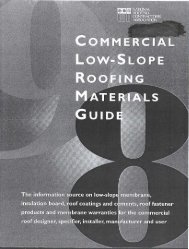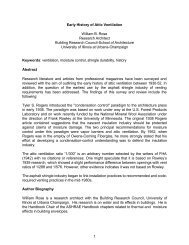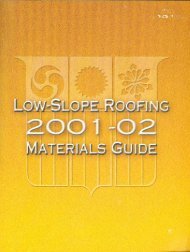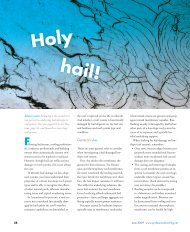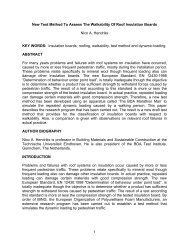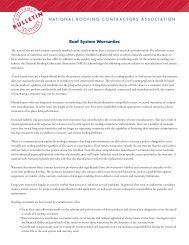Untitled - National Roofing Contractors Association
Untitled - National Roofing Contractors Association
Untitled - National Roofing Contractors Association
You also want an ePaper? Increase the reach of your titles
YUMPU automatically turns print PDFs into web optimized ePapers that Google loves.
Membrane application to these decks should follow the<br />
deck manufacturer's recommendations. Generally, attachment<br />
of the base ply with approved mechanical fasteners<br />
is recommended. If insulation is used, a nailable<br />
base ply is required as the attachment layer. Insulation<br />
should then be solidly adhered to the base ply with hot<br />
asphalt only. Adequate ventilation of the underside of the<br />
deck during the construction process is mandatory. In<br />
no case should the first ply of the roof membrane be<br />
mopped directly to precast planks.<br />
XIV.<br />
PRECAST/PRESTRESSED<br />
CONCRETE DECKS<br />
Precast concrete units are used as structural roof decks.<br />
The manufacturing process of precast concrete units may<br />
produce units that vary in joint elevation when set in<br />
place. If variations in the elevations of adjacent units exceed<br />
1/4 inch, the deck should be leveled with a fibrous<br />
cementitious grout that has been feathered to a slope<br />
of 1/8 inch per foot prior to roofing. Venting for this fill<br />
should be provided. A vapor retarder may be required,<br />
depending on the fill material used. (See Section X, Vapor<br />
Retarders.) The joints between adjacent units should<br />
be filled with a compressible material to prevent drippage<br />
of the cementitious fill that is used to level the units.<br />
Recommendations of the Precast Concrete Institute for<br />
deck installation should be followed. Weld plates should<br />
be provided between other structural components and<br />
the deck units and between the deck units themselves.<br />
The top surface is sometimes neglected in the casting<br />
of precast units. A smooth surface, free of voids and<br />
depressions, should be provided for proper adhesion of<br />
the roof system. In order to provide adequate drainage,<br />
the designer must consider the "bowing" (or vertical<br />
camber) of precast units that occurs in the manufacturing<br />
process of the units. Depending on structural design<br />
and drain placement, the camber may assist or restrict<br />
drainage. (See Section VI, Slope and Drainage.)<br />
The designer should carefully detail all wood blocking<br />
provisions at roof edges and penetrations to ensure pr0per<br />
attachment of the membrane and sheet metal. In no<br />
case should the roof membrane be attached directly to<br />
precast/prestressed concrete decks. Preformed roof insulation<br />
(preferably in two layers) should be installed on<br />
top of the deck before application of roof membrane<br />
materials.<br />
When precast walls are used, the designer should carefully<br />
consider the flashing provisions required to properly<br />
secure the roof to the precast wall units. Cast-in reglets,<br />
which are frequently used for this purpose, are difficult<br />
to align properly. When they are not properly aligned,<br />
they can hinder the proper installation of counterflashing.<br />
For this reason the use of cast-in reglets is not recommended.<br />
In all such flashings situations, consideration<br />
should be given to camber and creep.<br />
When precast walls are used, it is recommended that pr0-<br />
visions be made for IaN parapet walls. The base flashing<br />
should be fastened to a vertical wood upright whose<br />
horizontal base is attached to the deck only. After the<br />
base flashing has been attached to the wood upright, the<br />
metal wall cap flashing may be installed. Then the counterflashing<br />
may be attached to the wall cap, extending<br />
down over the top of the base flashing. This method allows<br />
lateral movements of the wall without damage to<br />
the base flashing.<br />
XV. REINFORCED CONCRETE DECKS<br />
Reinforced concrete is used as a structural deck. The<br />
pouring process requires large quantities of water, and<br />
some moisture will remain in concrete decks even after<br />
the surface is dry. Prior to the application of roofing<br />
materials, the concrete surface must be smooth, level<br />
and free of moisture. The deck contractor is responsible<br />
for removing sharp ridges or other irregularities in the<br />
deck surface. Wood bk>cking nailers should be designed<br />
and provided at all roof perimeters and penetrations for<br />
22 23




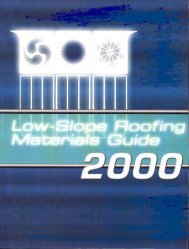
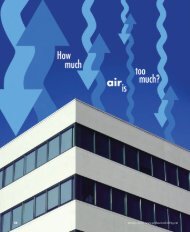

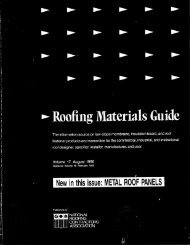
![Wm] - National Roofing Contractors Association](https://img.yumpu.com/36696816/1/190x245/wm-national-roofing-contractors-association.jpg?quality=85)

